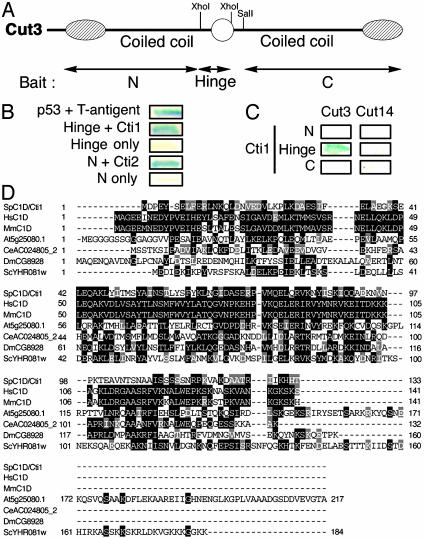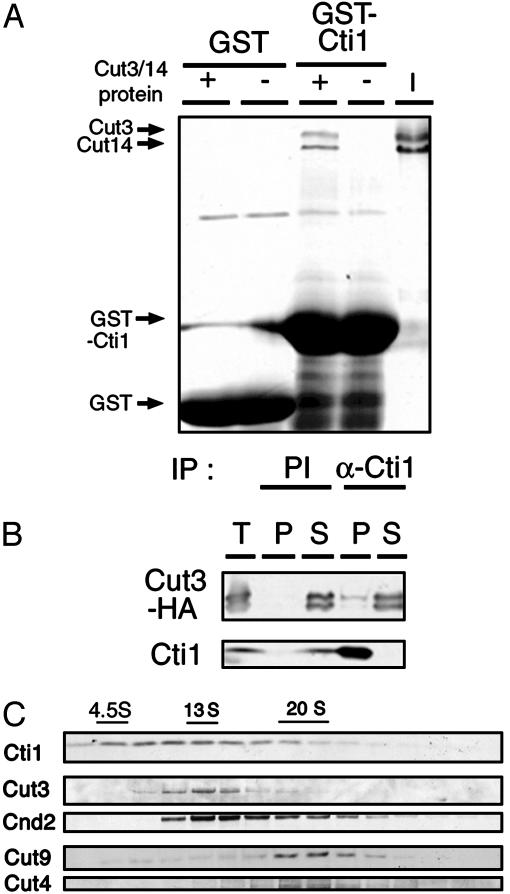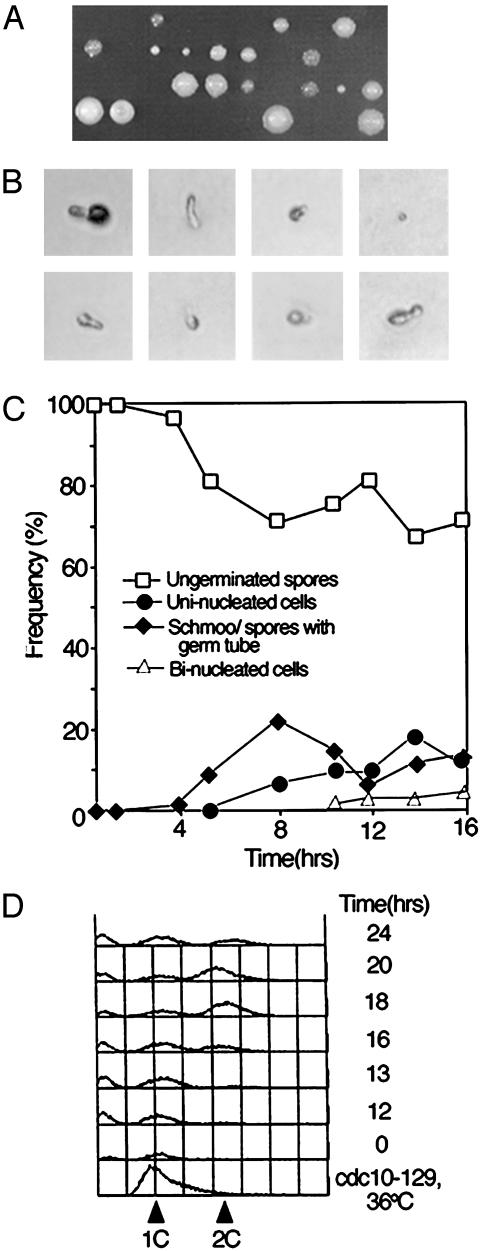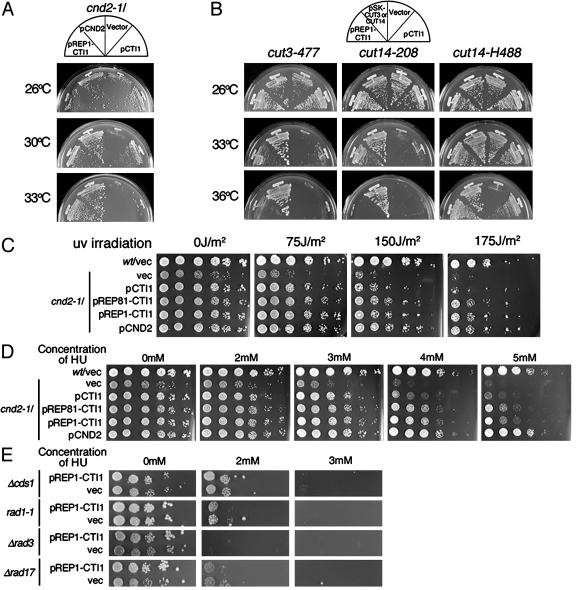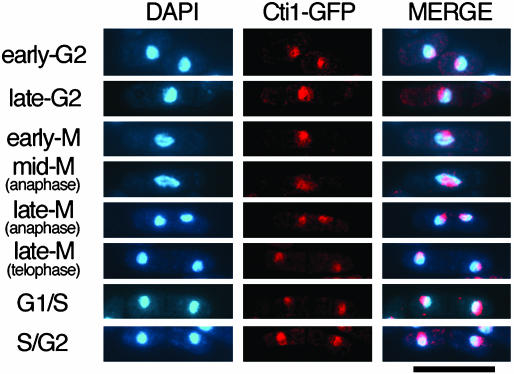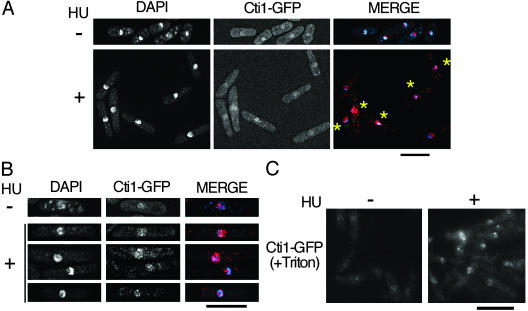Abstract
Condensin is a conserved five-subunit complex containing two SMC (structural maintenance of chromosomes) and three non-SMC subunits and plays a major role in mitotic chromosome condensation. Condensin also acts in interphase and is required for DNA repair and replication checkpoint control. We attempted to study the function of the condensin in greater detail by means of the isolation of interacting proteins with the two-hybrid system. Using the hinge domain of Cut3/SMC4 as bait, we found one Cut three-interacting (Cti) 14-kDa nuclear protein, Cti1. GST pull-down assay and immunoprecipitation supported physical interaction between Cti1 and condensin. Cti1 is similar to human C1D, which associates tightly with genomic DNA and functions to activate DNA protein kinase. SpC1D is essential for viability. The null mutant could germinate but arrest after replication, indicating that it is required for interphase growth. Importantly, an elevated dosage of spC1D suppressed the temperature, UV irradiation, and hydroxyurea sensitivity of the mutant of Cnd2, a non-SMC subunit of condensin. Upon exposure to hydroxyurea, spC1D accumulated on the nuclear chromatin, and the fraction of spC1D that was chromatin-bound increased. Cti1 is the first example of the protein that interacts with the hinge domain of SMC. Cti1 may have a supporting role for the DNA repair function of condensin.
Chromosomes are organized into higher-order structures, which change remarkably through the course of cell cycle. One of such structural changes is chromosome condensation, which involves the compaction of the whole genome before mitosis and is an essential prerequisite for faithful chromosome segregation (1). SMC (structural maintenance of chromosomes) proteins constitute a family of proteins that share a common architecture, in which a long coiled-coil rod connects two terminal globular regions. The coiled-coil region is disrupted in the middle by a hinge region. Members of the SMC family can be found in a wide range of organisms from bacteria to human and are involved in the processes like chromosome condensation, sister chromatid cohesion, dosage compensation, and DNA repair (2).
Condensin is a five-subunit protein complex comprising of two SMC and three non-SMC subunits (3, 4), essential for chromosome condensation (2, 4, 5). Fission yeast condensin has been found to possess ATP-independent DNA renaturation activity (6, 7), and ATP-dependent positive supercoiling activity has been discovered in Xenopus and human condensin (8–10). However, the molecular mechanism used by condensin to bring about the condensation of chromosome remains largely elusive. Unexpectedly, condensin has been recently shown to be essential for the repair of DNA damage and recovery from DNA replication block in interphase (11).
We have performed two-hybrid screening with the different domains of Cut3, one of the two SMC subunits of the fission yeast condensin, as baits and isolated Cti1, a Cut three-hinge-interacting nuclear protein. Cti1 is essential for cell growth and interestingly complemented the hypersensitivity of a condensin subunit mutant cnd2-1, for DNA damage agents. Together with the observation that the localization of Cti1 changes in response to DNA damage, we propose that Cti1 functions with condensin in the interphase DNA repair role.
Experimental Procedures
Strains and Media. Haploid wild-type Schizosaccharomyces pombe h– 972 and h+ 975 (12) and their derivative mutant strains were used. Schizosaccharomyces pombe haploid strains cut3-477, cut14-208, cnd2-1, Δcds1, rad1-1, Δrad3, and Δrad17 have been described (11, 13, 14). Cut14-H488 is another allele of cut14+ that was isolated from a recent large-scale temperature-sensitive (ts) mutant screen (15). The complete yeast extract/peptone/dextrose medium and Edinburgh minimal media 2 (EMM2) media were used (16). Cell cycle synchronization employing cdc25-22 mutation has been described (17).
Two-Hybrid Screening. Screening was performed in Saccharomyces cerevisiae HF7c strain with Schizosaccharomyces pombe cDNA Matchmaker library (XL4000AA, Clontech). Baits were constructed by inserting the appropriate restriction fragments from cut3+ ORF so that they were in-frame with the GAL4 DNA-binding domain in pGBN9 vector. Positive clones were selected on the basis of their complementation of the histidine auxotrophy and the expression of β-galactosidase reporter gene. Approximately 1 × 107 clones were screened for each of the baits. Interaction between p53 and T-antigen was used as the positive control. For the construction of the two-hybrid plasmids of Cut14, the XhoI and BglII sites on the gene flanking the hinge region were used.
Protein Manipulation. The ORF of cti1+ was inserted downstream of the GST tag in pGEX-KG vector (18). GST-Cti1 was expressed in bacteria and purified by using Glutathione Sepharose 4B resin (Amersham Biosciences) according to the manufacturer's instructions. Resin-bound GST and GST-Cti1 were mixed with 2 μg of Cut3/Cut14 heterodimers, purified from fission yeast (3, 6), in ice-cold binding buffer containing 20 mM Tris·HCl (pH 7.5), 100 mM NaCl, 10% glycerol, 0.02% Nonidet P-40, 0.1 mM PMSF, and 1 mM DTT. The bound proteins on beads were purified, washed three times with ice-cold binding buffer, resolved in SDS/PAGE gel, and stained with Coomassie brilliant blue.
The purified GST-Cti1 was also injected into rabbit for the production of α-Cti1 antibody. HB buffer [25 mM Tris·HCl, pH 7.5/15 mM EGTA/15 mM MgCl2/60 mM β-glycerophosphate/15 mM p-nitrophenylphosphate/0.5 mM Na3VO4/0.1 mM NaF/1mMDTT/0.1% Nonidet P-40/1 mM PMSF/0.01 vol Trasylol (Bayer)] was used for immunoprecipitation and sucrose gradient centrifugation (3, 6).
Gene Disruption, FACScan (Becton Dickinson), and Florescence Microscopy. One-step homologous recombination replacement method (19) was used for gene disruption in wild-type diploid strain. The ura4+ marker gene was inserted into the chromosomal locus such that the whole cti1+ was replaced. Southern hybridization was used to ensure that the gene disruption took place at the correct locus. Tetrad dissection of the sporulated disruption diploid strain was used to check the essentiality of the gene. The complementation of the loss of viability of the null mutant by the multicopy plasmid carrying the cti1+ under the control of its native promoter was also checked.
The FACScan protocol is described in refs. 11 and 20. DAPI (4′,6-diamidino-2-phenylindole) staining was done as (17). Cells were fixed in methanol before GFP florescence observation.
To observe chromatin-bound proteins, cells were treated with zymolyase, washed with buffer (20 mM Pipes-KOH, pH 6.8/0.4 M sorbitol/2 mM magnesium acetate/150 mM potassium acetate) containing 10% (wt/vol) Triton X-100 (21), before acetone fixation and microscopy.
Results
Cloning of Cti1. For the two-hybrid screen (22), the N-terminal, C-terminal, and hinge domains of Cut3/SMC4 were fused in-frame to the GAL4 DNA-binding domain (GAL4BD) and used as baits (Fig. 1A). Approximately 1 × 107 colonies were screened by using each of the baits. Ten and one positive cDNA clones, respectively, were obtained from the hinge and N-terminal baits. By using a combination of Southern hybridization and sequencing, all of the 10 positives interacting with the hinge bait were confirmed to be identical and contain a single ORF, spcc1739.07, designated Cut-three interacting protein 1 (Cti1). The N-terminal interacting protein is spcc1906.02c, a CUE domain protein (23) designated Cti2. The degree of interaction between Cti1 and Cut3 was as strong as that of the positive control between p53 and T-antigen (Fig. 1B). Neither Cti1 nor the Cut3 hinge domain alone induced any noticeable activation of the marker gene.
Fig. 1.
Cti1/spC1D is a conserved 133-aa protein that interacts with the hinge domain of Cut3/Smc4. (A) Three baits corresponding to the N, hinge, and C termini of Cut3/Smc4 have been used. Hatched ovals, globular domains of Cut3; circle, hinge region; bold line, coiled-coil rod. The indicated restriction sites (XhoI and SalI) were used in the construction of these baits. (B) Two-hybrid interactions between Cti1 and Cti2 with the hinge and N terminus of Cut3, respectively, as indicated by the expression of the β-galactosidase marker gene. Interaction between p53 and T antigen was used as the positive control. Neither of the baits (Hinge only and N only) caused unspecific expression of the marker gene. (C) Cti1 did not interact with Cut14/Smc2 or the amino and carboxyl domains of Cut3. Two-hybrid interactions between Cti1 and the N, hinge, and C domains of Cut3 (Left) and Cut14 (Right) were examined. (D) Proteins of C1D family showing high similarity to Cti1/spC1D are present in human, mouse, plant, fruit fly, worm, and the budding yeast. Identical and similar amino acids are shaded in black and gray, respectively. Hs, Homo sapiens; Mm, Mus musculus; At, Arabidopsis thaliana; Dm, Drosophila melanogaster; Ce, Caenorhabditis elegans; Sp, Schizosaccharomyces pombe; Sc, Saccharomyces cerevisiae. The alignment was obtained by using clustalw (35). The sequences are arranged in the order of descending similarity as predicted by the program.
Cut3 forms a heterodimer with its SMC partner Cut14 (6) and so we tested whether Cti1 also interacts with Cut14. For this aim, the N-terminal, hinge, and C-terminal domains of Cut14 were also fused in-frame to GAL4BD and tested for two-hybrid interaction with Cti1. At the same time, the interaction of Cti1 with the amino and carboxyl domains of Cut3 was also studied. As observed in Fig. 1C, Cti1 did not interact with the other domains of Cut3 nor Cut14.
The cti1+ gene encodes a 14-kDa protein (133 aa) and is highly charged with acidic N and basic C termini. The fission yeast cDNA library was screened with the ORF of cti1+ to isolate full-length cDNA clones. Sequencing of the cDNA clones obtained revealed no other methionine residue in the upstream region of the start codon predicted by the GenBank database.
Cti1 shows a striking similarity to human C1D (Fig. 1D) (24). C1D was reported to interact with several proteins, including transcription repressor-nuclear hormone receptor (25), TRAX, which binds the single-stranded DNA-binding protein Translin (26), small GTPase Rac3 (27), and the DNA-damage responding phosphatidylinositol 3-kinase-like kinase, DNA protein kinase (DNA-PK) (28). The interaction with DNA-PK was of considerable interest because DNA-PK can be activated by C1D even without the presence of free DNA ends (28). The null mutant of the budding yeast homologue of C1D, yC1D, has been shown to be defective in the nonhomologous end-joining pathway for repairing double-stranded DNA breaks (29).
Cti1 Interacts with Cut3 in Vitro and in Vivo. To examine whether Cti1 and Cut3 interacted physically, the in vitro GST pull-down assay was performed. Recombinant protein containing Cti1 fused at the N terminus to the GST tag (GST-Cti1) was purified from bacteria and incubated with purified Cut3–Cut14 heterodimer (6). Although the negative control with GST tag alone showed no interaction, a portion of the heterodimer was coprecipitated with GST-Cti1 in vitro, suggesting physical affinity between Cti1 and the Cut3–Cut14 heterodimer (Fig. 2A).
Fig. 2.
Cti1/spC1D interacts physically with Cut3/Smc4 in vitro and in vivo. (A) Cti1 interacts with the Cut3/Smc4–Cut14/Smc2 heterodimer in vitro. GST and GST-Cti1 fusion proteins were expressed and purified from Escherichia coli, adsorbed onto glutathione Sepharose beads, and incubated with purified Cut3–Cut14 complex. Shown is the Coomassie blue staining of the proteins resolved by PAGE. + and –, presence and absence of Cut3–Cut14, respectively; I, initial amount of the Cut3–Cut14 complex used. (B) Cti1/spC1D and Cut3/Smc4 interact in vivo. Immunoprecipitation (IP) was performed with α-Cti1 antibody by using the extract of the asynchronous culture of wild-type strain carrying Cut3-HA integrated at the native locus. Immunoblot was performed with antibodies directed against HA and Cti1 to detect Cut3-HA and Cti1, respectively. Immunoprecipitation with the preimmune serum was used as the negative control. T, total input; P, precipitated fraction, loaded at 50 times the amount of input; S, supernatant, unbound fraction. IP was performed in HB buffer [25 mM Tris·HCl, pH 7.5/15 mM EGTA/15 mM MgCl2/60 mM β-glycerophosphate/15 mM p-nitrophenylphosphate/0.5 mM Na3VO4/0.1 mM NaF/1 mM DTT/0.1% Nonidet P-40/1 mM PMSF/0.01 vol Trasylol (Bayer)]. (C) Sucrose gradient centrifugation patterns of Cti1/spC1D, the condensin subunits, Cut3/Smc4, Cnd2/Barren, and APC (anaphase promoting complex)/cyclosome subunits Cut4 and Cut9. Condensin subunits show a peak at 13S, whereas that of APC/cyclosome peaked at 20S. Cti1/spC1D shows distribution from 4S to 15S, partially overlapped with the distribution of condensin.
To investigate the physical interaction in vivo, rabbit polyclonal antibody against Cti1 was prepared. Immunoprecipitation was performed by using extracts of wild-type cells integrated with native promoter-controlled HA-tagged Cut3 gene. The precipitated Cti1 and Cut3-HA proteins were detected by using anti-Cti1 and anti-HA (12CA5) antibodies, respectively. Although the negative control with preimmune serum (PI) did not show any precipitation of Cut3-HA, a small portion of Cut3-HA was coimmunoprecipitated with Cti1, when using Cti1 antiserum (Fig. 2B). In a reciprocal immunoprecipitation experiment employing anti-HA antibodies, Cti1 was also coprecipitated with Cut3-HA (data not shown). The interaction between these proteins, however, was weak and might be transient.
Sucrose gradient sedimentation of the wild-type extracts was performed (Fig. 2C). Cti1 exhibited a broad sedimentation profile ranging between 4.5S and 15S, overlapped with the peak of 13S holocondensin complex (6).
Cti1 Is Essential for Growth. To investigate the null phenotype of cti1+, heterozygous diploid was created by one-step replacement of the whole coding region with the ura4+ maker. After sporulation, the tetrads were dissected and only two viable spores were obtained for each of the tetrads incubated at various temperatures from 20°Cto36°C (Fig. 3A and data not shown). All viable spores were Ura–, demonstrating that cti1+ is essential for cell viability. The nonviable null mutant spores either did not properly germinate or stopped growth after protruding a short germ tube, suggesting that cells did not enter the growth phase (Fig. 3B).
Fig. 3.
Phenotypes of the cti1 null mutant. (A) cti1+ is an essential gene. Tetrad dissection of the sporulated heterozygous diploid containing a null mutation revealed a 2:2 segregation pattern of viable:inviable spores. (B) Germination phenotype of eight spores in A growing on yeast extract/peptone/dextrose plate at 33°C. (C) Phenotypes of the null mutant germinated in liquid EMM2 (without uracil) culture. Samples were taken hourly and DAPI-stained to count the nuclear phenotypes. (D) FACScan profile of C. cdc10-129 is a ts mutant that arrested at 36°C with a 1C DNA content and, hence, was used as the marker of the 1C peak.
The spores were cultured in the selective liquid medium, in which only the Ura+ null mutant could germinate. Consistently, a large proportion (≈70%) of spores, perhaps Ura–, remained as spores (Fig. 3C). A portion of spores (≈20%) germinated but barely divided. Binucleated cells were observed later at a very low frequency (2.4%). These results showed that Cti1 is required for the interphase growth function. To determine whether DNA replication occurred, FACScan was performed to monitor the change in DNA content (Fig. 3D). Replication seemed to occur ≈13 h after germination, like the timing in wild-type cells (20). Hence, the terminal phenotypes of cti1 null appeared to be the inability to grow and divide. Growth of null cells seemed to be blocked after replication but before mitosis.
The Phenotypes of cnd2-1 Rescued by Plasmid pCTI1. Non-SMC mutant cnd2-1 exhibits hypersensitivity to DNA-damaging agents and deficiency in UV-induced damage repair as well as the Cds1/Chk2-checkpoint-dependent cell-cycle delay (11). We assessed the functional link between Cti1 and the DNA repair function of Cnd2 by transforming cnd2-1 mutant with plasmids carrying the cti1+ gene placed under the control of either native promoter or the inducible REP1 overexpression promoter (30, 31). These plasmids could suppress the temperature sensitivity of cnd2-1 (Fig. 4A). Suppression occurred as efficiently as in pCND2 plasmid carrying the cnd2+ gene expressed under native promoter. To determine whether such overexpression was specific to the mutant of Cnd2, the suppression of one cut3 and two cut14 mutants was studied. The suppression also occurred for cut3-477, albeit at a weaker extent relative to cnd2-1 at 33°C (Fig. 4B). For cut14 mutants, one allele H488 was suppressed at 36°C. These results strongly suggest the close functional linkage between condensin and spC1D/Cti1.
Fig. 4.
Overexpressed Cti1/spC1D suppresses ts phenotype, UV, and HU sensitivity of cnd2-1 and ts phenotype of cut3-477 and cut14-H488. Thiamin was absent in all of the plates to allow activation of the promoter. (A) cnd2-1, the ts mutant of the condensin subunit Cnd2/Barren, was transformed with multicopy plasmids of Cti1 placed under the control of its native promoter (pCTI1) and inducible overexpression REP1 promoter (pREP1-CTI1), empty vector (Vector), and multicopy plasmid carrying Cnd2 under its native promoter (pCND2). (B) Overexpression of Cti1/spC1D partially suppressed the ts phenotype of condensin SMC mutants, cut3 and cut14. pSK-CUT3 and CUT14 are native promoter-driven cut3+ or cut14+. (C) The Barren mutant cnd2-1 carrying the indicated plasmids was spotted onto EMM2 plates. After UV irradiation, cells were grown at 26°C. Wild-type cells carrying the empty vector (wt/vec) were used as the positive control. vec, empty vector; pREP81-CTI1, cti1+ under the control of REP81 promoter; pREP1-CTI1, cti1+ under the control of REP1 promoter. (D) The same strains in C was spotted on EMM2 plates containing the indicated amount of HU and grown at 26°C. (E) REP1-CTI1 and vector were transformed into Δcds1, rad1-1, Δrad3, and Δrad17, and transformants grown on EMM2 plates were added with the indicated amount of HU, at 26°C.
Next, the effect of Cti1 overexpression on the hypersensitivity of cnd2-1 to UV irradiation as well as the ribonucleotide reductase inhibitor hydroxyurea (HU) was investigated. Transformants of cnd2-1 carrying plasmids containing the cti1+ gene placed under the control of the inducible REP1 and REP81 promoters (REP81 is a weaker promoter compared to REP1) were serial-diluted and spotted on the minimal medium plates. The cells were then exposed to varying levels of UV irradiation and grew at 26°C. The suppression was surprisingly strong, almost equivalent to the extent of suppression by the wild-type cnd2+ gene (Fig. 4C), even when expressed from relatively mild REP81 promoter. Suppression of the HU hypersensitivity of cnd2-1 by REP1 and REP81-based plasmids containing the cti1+ gene was examined in a similar way. Overexpression of Cti1 promoted the growth of cnd2-1, relative to the vector, up to 4 mM of HU (Fig. 4D). The elevated level of Cti1/spC1D thus suppressed most defects of condensin mutants, suggesting its close relationship to Cnd2. Suppression of the UV and HU sensitivity was strong, whereas suppression of the ts phenotype was relatively weak. Cti1 was also overexpressed in other HU-sensitive mutants such as Δcds1, rad1-1, Δrad3, and Δrad17 (11, 13). We found that Cti1 did not suppress these HU-sensitive mutants. These results shown in Fig. 4E indicated that the suppression by Cti1 was specific to cnd2-1 rather than through a broad role of Cti1 in DNA-damage response.
Cti1/spC1D Localizes to the Nucleus Showing Accumulation in the Nucleolus. The subcellular localization of Cti1 was investigated by tagging the cti1+ gene with GFP at the C terminus and integrated onto chromosome under control of the native promoter. The resulting strain was cultured in EMM2 at 26°C, and the pattern of the GFP fluorescence studied with counterstaining by DAPI. Cti1 was localized in the nucleus throughout the cell cycle and enriched in the nucleolar region that contained ribosomal DNA (Fig. 5). Chromatin staining of Cti1 is relatively weak, and looks fuzzy and irregular. This staining pattern did not alter during the cell cycle. Immunoblotting of block-released cdc25-22 synchronized cells by using anti-Cti1 antibodies revealed that the Cti1 protein level remained constant throughout the cell cycle (data not shown).
Fig. 5.
Cti1/spC1D is a nuclear protein that shows accumulation in the nucleolus. Wild-type cells carrying the integrated Cti1-GFP at the lys1+ locus were cultured in EMM2 at 26°C. Cells were fixed with methanol. Illustrated is the localization of the Cti1-GFP fusion protein in nine cells at different stage of the cell cycle. Nuclear chromatin DNA was stained with DAPI (blue, Left). GFP florescence is denoted in red (Center), and the merged images between the DAPI and GFP fluorescence are shown in Right. (Scale bar, 10 μm.)
Cti1 Chromatin Localization Altered in Response to HU. To examine whether Cti1 might change its localization upon HU treatment, 15 mM HU was added to the culture media of Cti1-GFP integrant wild-type strain to activate the intra-S-phase check-point (EMM2, 5 h at 33°C). Cti1-GFP showed a significant localization change in cells exposed to HU (Fig. 6 A and B). In most of the treated cells, a bright GFP signal was observed in a broader area of the cell nucleus than in the untreated cells (cells revealing the changes are indicated by asterisks). Merging with DAPI-stained images revealed that bright GFP-Cti1 signal was no longer restricted in the nucleolar compartment, but the chromatin region also showed the intense GFP signal in the presence of HU (enlarged in Fig. 6B). Immunoblotting with Cti1 antiserum confirmed that the protein level of HU-treated cells was similar to that of the untreated control (data not shown). The HU-treated cells were washed with the detergent Triton X-100 to remove the non-chromatin-bound proteins (21). The increase in Cti1-GFP signal after HU treatment suggested that the chromatin binding of Cti1 increased upon HU treatment (Fig. 6C).
Fig. 6.
Nuclear localization pattern of Cti1 altered in response to HU treatment. (A) Localization of Cti1-GFP after 5 h upon the addition of 15 mM HU (Lower), in EMM2 at 33°C. Cells were methanol-fixed before observation with a DeltaVision (Applied Precision, Issaquah, WA) microscope. Control cells in the absence of HU show intense staining in the nucleolar region. Asterisks indicate cells that revealed strong signals spread to the nuclear chromatin region in the presence of HU. (B) Enlarged micrographs of cells from A in the presence and the absence of HU. (C) After HU treatment (+), a larger amount of Cti1-GFP remained chromatin-bound compared to the nontreated (–) cells. The strain used in A were treated with HU as described, then washed in Triton X-100-containing buffer to remove the non-chromatin-bound proteins before fixation in acetone. Intense signals in nuclear chromatin remained in HU-treated cells after Triton washing, but not in HU-untreated cells. (Scale bars, 10 μm.)
Discussion
In this study, we report on the isolation of an essential nuclear protein, Cti1/spC1D, in fission yeast that interacts with Cut3/Smc4, an essential SMC subunit of condensin. Cti1 belongs to a highly conserved family of C1D proteins, and some of the C1D homologues are implicated in DNA-repair function (28, 29). Cti1/spC1D is an example of an SMC hinge-interacting protein and, to our knowledge, the first protein, other than the members of the condensin complex, that physically interacts with Cut3/Smc4.
Cti1 shows a strong genetic interaction with Cnd2/Barren, an essential non-SMC subunit of the condensin complex in fission yeast. The UV and HU hypersensitivities of cnd2-1 mutant are suppressed by pCTI1. Cti1 also showed genetic interaction with other members of the condensin. Furthermore, the localization pattern of Cti1 is altered in response to DNA damage induced by the DNA-replication inhibitor HU. Cti1 appears to be involved in the recently uncovered interphase function (11) of the condensin.
Up to now, six proteins have been reported to interact with mammalian C1D: the transcriptional repressor RevErb, the two coreppressors NcoR and SMRT (25), TRAX (26), Rac3 (27), and DNA protein kinase (28). These proteins may function in different pathways but most are involved in chromatin dynamics. C1D and its studied homologues are related to two cellular processes, transcription and genome maintenance. Although it is unknown whether condensin is implicated in these different gene functions, a part of C1D interacting proteins might link to condensin. Atomic force microscopy (AFM) of purified condensin holo-complex revealed that the hinge of SMC was contacted to DNA (32). Together with the report that human C1D binds strongly to DNA (24), it is possible that Cti1/spC1D interacts with chromatin DNA. Cti1 might be envisaged to function as the recruiter of the condensin complex to the site of DNA damage induced by the HU treatment.
The cnd2-1 mutant failed to repair DNA damages, leading to the observed hypersensitivities toward UV and HU (11). Overexpression of Cti1 suppresses the hypersensitivities of cnd2-1, possibly through efficient exposure of the damaged lesions to condensin. The suppression is not just limited to the damage sensitivities of cnd2 mutant but extended to the ts phenotypes of cnd2 and other SMC condensin mutants. This finding further supports a model that a part of Cti1 functions is to up-regulate the whole condensin complex.
The reason for the ribosomal DNA region accumulation of Cti1 is unclear, but Cti1 might regulate ribosomal DNA metabolism or rRNA maturation. Recently the budding yeast C1D homologue has been found to associate with exosome, the disruption of which led to the defective processing of ribosomal, spliceosomal, and small nuclear RNAs (33, 34). If fission yeast Cti1 is also involved in ribosomal DNA processing, a fundamental requirement for cellular growth, then it would not be surprising that the disruption of cti1+ led to the inability to germinate and the inhibition of growth as observed. Moreover, the localization and phenotypes of cti1 null mutant resembles closely that caused by mutation in Mis3 (20), a K-homology-domain-containing protein essential for the processing of rRNA. The nucleolar region might, at the same time, also act as a reservoir of Cti1, and in the presence of DNA damage signals, Cti1 might be released and redistributed to the spots of action.
Acknowledgments
We thank the members of the lab of M.Y. for discussion and technical assistance. We especially thank N. Aono, who helped greatly in coimmunoprecipitation experiments. This work was supported by the Core Research for Evolutional Science and Technology research grant of the Japan Science and Technology Corporation (to M.Y.), and by the Center of Excellence scientific research grant of the Ministry of Education, Culture, Sports, Science, and Technology of Japan (to M.Y.). E.S.C. is a recipient of the Predoctoral Foreign Student Fellowship of the Ministry of Education, Culture, Sports, Science, and Technology of Japan and a postdoctoral fellowship from the Japan Society for the Promotion of Science.
This paper was submitted directly (Track II) to the PNAS office.
Abbreviations: DAPI, 4′,6-diamidino-2-phenylindole; EMM2; Edinburgh minimal media 2; HU, hydroxyurea; ts, temperature-sensitive.
References
- 1.Swedlow, J. R. & Hirano, T. (2003) Mol. Cell 11, 557–569. [DOI] [PubMed] [Google Scholar]
- 2.Hirano, T. (2002) Genes Dev. 16, 399–414. [DOI] [PubMed] [Google Scholar]
- 3.Sutani, T., Yuasa, T., Tomonaga, T., Dohmae, N., Takio, K. & Yanagida, M. (1999) Genes Dev. 13, 2271–2283. [DOI] [PMC free article] [PubMed] [Google Scholar]
- 4.Hirano, T., Kobayashi, R. & Hirano, M. (1997) Cell 89, 511–521. [DOI] [PubMed] [Google Scholar]
- 5.Freeman, L., Aragon-Alcaide, L. & Strunnikov, A. (2000) J. Cell Biol. 149, 811–824. [DOI] [PMC free article] [PubMed] [Google Scholar]
- 6.Sutani, T. & Yanagida, M. (1997) Nature 388, 798–801. [DOI] [PubMed] [Google Scholar]
- 7.Sakai, A., Hizume, K., Sutani, T., Takeyasu, K. & Yanagida, M. (2003) EMBO J. 22, 2764–2775. [DOI] [PMC free article] [PubMed] [Google Scholar]
- 8.Kimura, K., Rybenkov, V. V., Crisona, N. J., Hirano, T. & Cozzarelli, N. R. (1999) Cell 98, 239–248. [DOI] [PubMed] [Google Scholar]
- 9.Kimura, K. & Hirano, T. (2000) Proc. Natl. Acad. Sci. USA 97, 11972–11977. [DOI] [PMC free article] [PubMed] [Google Scholar]
- 10.Kimura, K., Cuvier, O. & Hirano, T. (2001) J. Biol. Chem. 276, 5417–5420. [DOI] [PubMed] [Google Scholar]
- 11.Aono, N., Sutani, T., Tomonaga, T., Mochida, S. & Yanagida, M. (2002) Nature 417, 197–202. [DOI] [PubMed] [Google Scholar]
- 12.Gutz, H., Heslot, H., Leupold, U. & Lopreno, N. (1974) in Schizosaccharomyces pombe, Handbook of Genetics 1, ed. King, R. C. (Plenum, New York), pp. 395–446.
- 13.Saka, Y., Esashi, F., Matsusaka, T., Mochida, S. & Yanagida, M. (1997) Genes Dev. 11, 3387–3400. [DOI] [PMC free article] [PubMed] [Google Scholar]
- 14.Saka, Y., Sutani, T., Yamashita, Y., Saitoh, S., Takeuchi, M., Nakaseko, Y. & Yanagida, M. (1994) EMBO J. 13, 4938–4952. [DOI] [PMC free article] [PubMed] [Google Scholar]
- 15.Matsumura, T., Yuasa, T., Hayashi, T., Obara, T., Kimata, Y. & Yanagida, M. (2003) Genes Cells 8, 341–355. [DOI] [PubMed] [Google Scholar]
- 16.Moreno, S., Klar, A. & Nurse, P. (1991) Methods Enzymol. 194, 795–823. [DOI] [PubMed] [Google Scholar]
- 17.Chen, E. S., Saitoh, S., Yanagida, M. & Takahashi, K. (2003) Mol. Cell 11, 175–187. [DOI] [PubMed] [Google Scholar]
- 18.Guan, K. L. & Dixon, J. E. (1991) Anal. Biochem. 192, 262–267. [DOI] [PubMed] [Google Scholar]
- 19.Rothstein, R. J. (1983) Methods Enzymol. 101, 202–211. [DOI] [PubMed] [Google Scholar]
- 20.Kondoh, H., Yuasa, T. & Yanagida, M. (2000) Genes Cells 5, 525–541. [DOI] [PubMed] [Google Scholar]
- 21.Kearsey, S. E., Montgomery, S., Labib, K. & Linder, K. (2000) EMBO J. 19, 1681–1690. [DOI] [PMC free article] [PubMed] [Google Scholar]
- 22.Fields, S. & Song, O. (1989) Nature 340, 245–246. [DOI] [PubMed] [Google Scholar]
- 23.Shih, S. C., Prag, G., Francis, S. A., Sutano, M. A., Hurley, J. H. & Hicke, L. (2003) EMBO J. 22, 1273–1281. [DOI] [PMC free article] [PubMed] [Google Scholar]
- 24.Nehls, P., Keck, T., Greferath, R., Spiess, E., Glaser, T., Rothbarth, K., Stammer, H. & Werner, D. (1998) Nucleic Acids Res. 26, 1160–1166. [DOI] [PMC free article] [PubMed] [Google Scholar]
- 25.Zamir, I., Dawson, J., Lavinsky, R. M., Glass, C. K., Rosenfeld, M. G. & Lazar, M. A. (1997) Proc. Natl. Acad. Sci. USA 94, 14400–14405. [DOI] [PMC free article] [PubMed] [Google Scholar]
- 26.Erdemir, T., Bilican, B., Oncel, D., Goding, C. R. & Yavuzer, U. (2002) J. Cell Sci. 115, 207–216. [DOI] [PubMed] [Google Scholar]
- 27.Haataja, L., Groffen, J. & Heisterkamp, N. (1998) Int. J. Mol. Med. 1, 665–670. [DOI] [PubMed] [Google Scholar]
- 28.Yavuzer, U., Smith, G. C., Bliss, T., Werner, D. & Jackson, S. P. (1998) Genes Dev. 12, 2188–2199. [DOI] [PMC free article] [PubMed] [Google Scholar]
- 29.Erdemir, T., Bilican, B., Cagatay, T., Goding, C. R. & Yavuzer, U. (2002) Mol. Microbiol. 46, 947–957. [DOI] [PubMed] [Google Scholar]
- 30.Maundrell, K. (1990) J. Biol. Chem. 265, 10857–10864. [PubMed] [Google Scholar]
- 31.Basi, G., Schmid, E. & Maundrell, K. (1993) Gene 123, 131–136. [DOI] [PubMed] [Google Scholar]
- 32.Yoshimura, S. H., Hizume, K., Murakami, A., Sutani, T., Takeyasu, K. & Yanagida, M. (2002) Curr. Biol. 12, 508–513. [DOI] [PubMed] [Google Scholar]
- 33.Peng, W. T., Robinson, M. D., Mnaimneh, S., Krogan, N. J., Cagney, G., Morris Q., Davierwala, A. P., Grigull, J., Yang, X., Zhang W., et al. (2003) Cell 113, 919–933. [DOI] [PubMed] [Google Scholar]
- 34.Mitchell, P., Petfalski, E., Houalla, R., Podtelejnikov, A., Mann, M. & Tollervey, D. (2003) Mol. Cell. Biol. 23, 6982–6992. [DOI] [PMC free article] [PubMed] [Google Scholar]
- 35.Higgins, D., Thompson, J., Gibson, T., Thompson, J. D., Higgins, D. G. & Gibson, T. J. (1994) Nucleic Acids Res. 22, 4673–4680. [DOI] [PMC free article] [PubMed] [Google Scholar]



